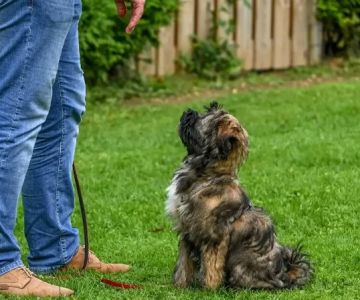- Understanding the Importance of Reliable Recall
- Foundations of Successful Off-Leash Training
- Building Reliable Recall Step by Step
- Common Mistakes and How to Avoid Them
- Real-Life Success Stories
- Maintaining Trust and Consistency
Understanding the Importance of Reliable Recall
Training your dog to come when called—no matter the situation—is one of the most important skills in off-leash training. Reliable recall is not just about obedience; it’s about safety and trust. A dog that returns instantly when called can avoid accidents, prevent conflicts with other animals, and enjoy greater freedom outdoors. It’s the foundation of a confident and happy relationship between you and your pet.
Many dog owners in the U.S. dream of letting their dogs run free in open spaces, from local parks to hiking trails. However, without strong recall training, this can quickly turn into a stressful experience. At Hidden Brook Veterinary, we often meet pet owners who struggle with dogs that bolt after squirrels or ignore commands when distracted. The good news is that with consistency and proper training methods, any dog can learn to respond reliably—even in challenging environments.
Foundations of Successful Off-Leash Training
1. Building Trust and Engagement
Before taking your dog off-leash, you need to establish trust and attention. Dogs respond best when they view their owners as the source of rewards, guidance, and security. Begin by practicing recall indoors or in a fenced yard where distractions are minimal. Use a cheerful tone, maintain eye contact, and always reward your dog for responding, even if it takes time.
Consistency is key. The more often you reinforce recall in calm situations, the more naturally your dog will respond in stimulating ones. Think of recall as a long-term investment—it’s built through repetition, patience, and positive energy.
2. Choosing the Right Equipment
For early off-leash training, tools like a long-line leash (20–30 feet) provide safety and control while allowing freedom to move. Avoid retractable leashes; they can confuse your dog about boundaries. Treat pouches, clickers, and high-value rewards like cooked chicken or cheese can make sessions engaging and rewarding.
3. Establishing a Positive Association with Recall
Never call your dog to scold or end something fun, like playtime. If your dog learns that “come” means “the fun is over,” they’ll start ignoring the command. Instead, make every recall a reason for celebration—praise, treats, or even a short game. Your dog should associate coming to you with excitement and comfort.
Building Reliable Recall Step by Step
1. Start Indoors or in a Controlled Space
Begin in a quiet, distraction-free environment. Call your dog using a clear, upbeat cue—like “Come!” or “Here!”—and reward them immediately when they arrive. Keep sessions short but frequent. Repetition helps strengthen the link between the cue and the action.
2. Increase Distance and Add Distractions Gradually
Once your dog consistently responds indoors, move to your backyard or a fenced park. Gradually add distractions such as toys, noises, or other people. Each successful recall in a new environment strengthens your dog’s reliability. Always end sessions on a positive note.
3. Use Recall Games to Build Excitement
Training should be fun for both of you. Try “Hide and Seek,” where you hide and call your dog to find you, or “Recall Races,” where two people call the dog alternately and reward them for running back and forth. These playful methods make recall a natural, enjoyable behavior.
4. Practice in Real-World Settings
Once your dog responds reliably in controlled spaces, it’s time to test recall in real environments like trails or beaches. Start with a long-line for safety and gradually phase it out. Remember, freedom is a privilege that must be earned through consistent practice and trust.
Common Mistakes and How to Avoid Them
1. Inconsistent Commands
Using different words or tones for recall can confuse your dog. Stick to one clear command and use it consistently. Avoid calling your dog repeatedly—say it once, then encourage with body language or movement if needed.
2. Punishing Late Responses
Never punish your dog for coming back, even if they took their time. Returning to you should always feel safe. If your dog hesitates, assess why—were they frightened, distracted, or confused? Understanding the cause will help improve your approach.
3. Skipping Reinforcement Too Soon
Some owners stop rewarding their dogs once they “know” the command. However, recall must remain valuable for the dog. Even as they master it, continue to praise or treat them occasionally to keep motivation high.
Real-Life Success Stories
1. Luna the Border Collie
Luna’s owners struggled with her chasing joggers at the park. After enrolling in structured recall training and practicing daily for three months, Luna learned to return instantly—even mid-chase. Her owner recalls, “It changed everything. We can finally enjoy off-leash walks without stress.”
2. Max’s Transformation from Reactive to Responsive
Max, a rescue German Shepherd, used to bolt when scared. Through patient desensitization and recall reinforcement, his owners built his confidence and reliability. Their consistent approach turned fearful reactions into calm responsiveness—a remarkable transformation that highlights the power of patience and training.
Maintaining Trust and Consistency
1. Reinforce Recall Throughout Your Dog’s Life
Recall is not a one-time lesson—it’s a lifelong practice. Continue incorporating short recall sessions into playtime or walks. Vary rewards to keep your dog engaged and excited to respond.
2. Strengthen the Bond with Your Dog
Off-leash reliability depends on trust as much as training. Spend quality time with your dog through play, cuddles, and adventure. The stronger your emotional bond, the more your dog will want to stay connected to you, even in tempting situations.
3. When to Seek Professional Help
If your dog struggles with recall despite consistent training, it may be time to consult a professional. Behavioral experts and veterinarians can identify underlying causes such as fear, overexcitement, or medical conditions. At Hidden Brook Veterinary, our team provides customized behavioral guidance and training support to help your pet thrive in off-leash settings.
Reliable recall takes time, but the reward—a confident, obedient dog that trusts you completely—is worth every effort. With consistent practice, positive reinforcement, and patience, your dog can enjoy the freedom of off-leash adventures safely and happily.










